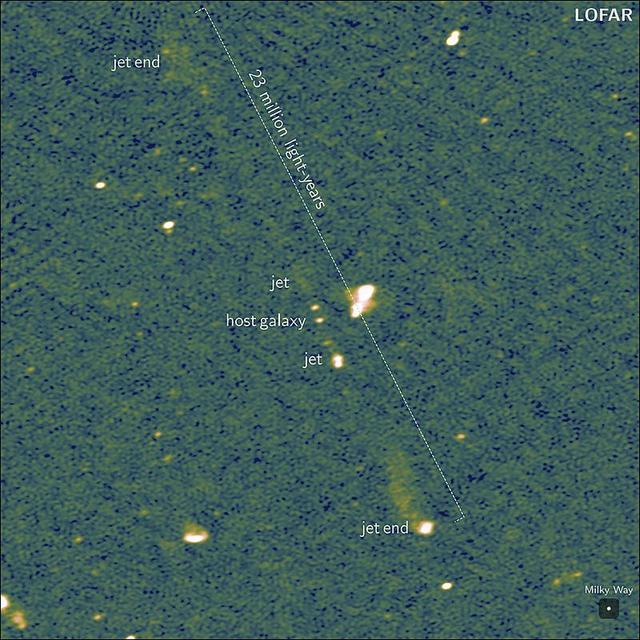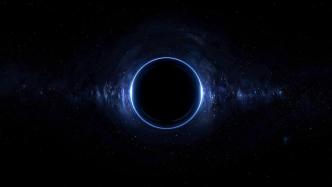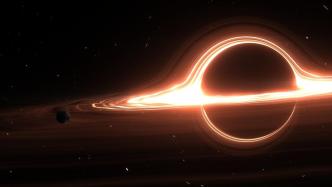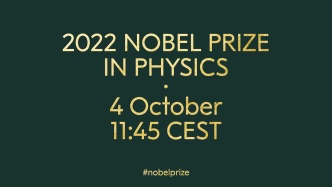
Another year of Nobel Prize season. According to the official website of the Nobel Prize, the list of winners of the 2022 Nobel Prize in Physics will be announced at the earliest at 11:45 CET on October 4 (17:45 Beijing time on October 4).
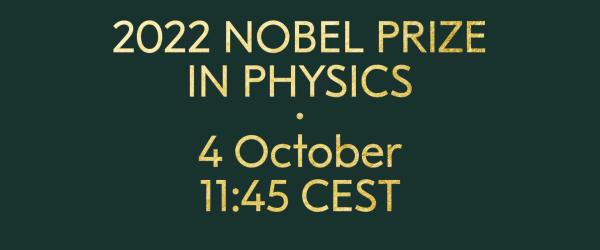
The list of 2022 Nobel Prize winners in physics will be announced at 17:45 on October 4, Beijing time at the earliest
In addition to a unique certificate and a gold medal, the 2022 Nobel Prize award amount is set at 10 million Swedish kronor (SEK) for each award, or about 6.4 million yuan.
Up to now, the Nobel Prize in Physics has been awarded 115 times, of which 47 are awarded to a single winner, 32 are shared by two winners, and 36 are shared by three winners.
From 1901 to 2021, the Nobel Prize in Physics has been awarded to 219 Nobel Laureates. John Bardeen is the only recipient of the Nobel Prize in Physics twice, in 1956 and 1972. This means a total of 218 people have won the Nobel Prize in Physics.
During the First World War (1914-1918) and the Second World War (1939-1945), during the six years of 1916, 1931, 1934, 1940, 1941, 1942, no promises were issued Bell Prize in Physics.
According to People's Daily Online, the Nobel Prize in Physics focuses on four areas: particle physics, astrophysics, condensed matter physics, atomic and molecular and photophysics.
In the 6 years from 2015 to 2020, research results in the field of astrophysics have won the Nobel Prize in Physics 4 times: in addition to cosmology theory and exoplanets in 2019, neutrino oscillations in 2015 ( It belongs to astrophysics or particle physics) and the discovery of gravitational waves in 2017; and the discovery of black holes in 2020 also belongs to the field of astrophysics.
The 2021 Nobel Prize in Physics: The Mystery of Complex Systems
The 2021 Nobel Prize in Physics is awarded to two groups of three physicists who study complex systems, one for the study of the Earth's climate system and the other for the study of complex physical systems ranging from atomic to planetary scales.
The Nobel Foundation's charter states that prize money can be divided equally between two works, or by two or three people. But in no case shall the prize be shared by more than three persons.
Three scientists have been awarded the 2021 Nobel Prize in Physics for "pioneering contributions to the understanding of complex physical systems".
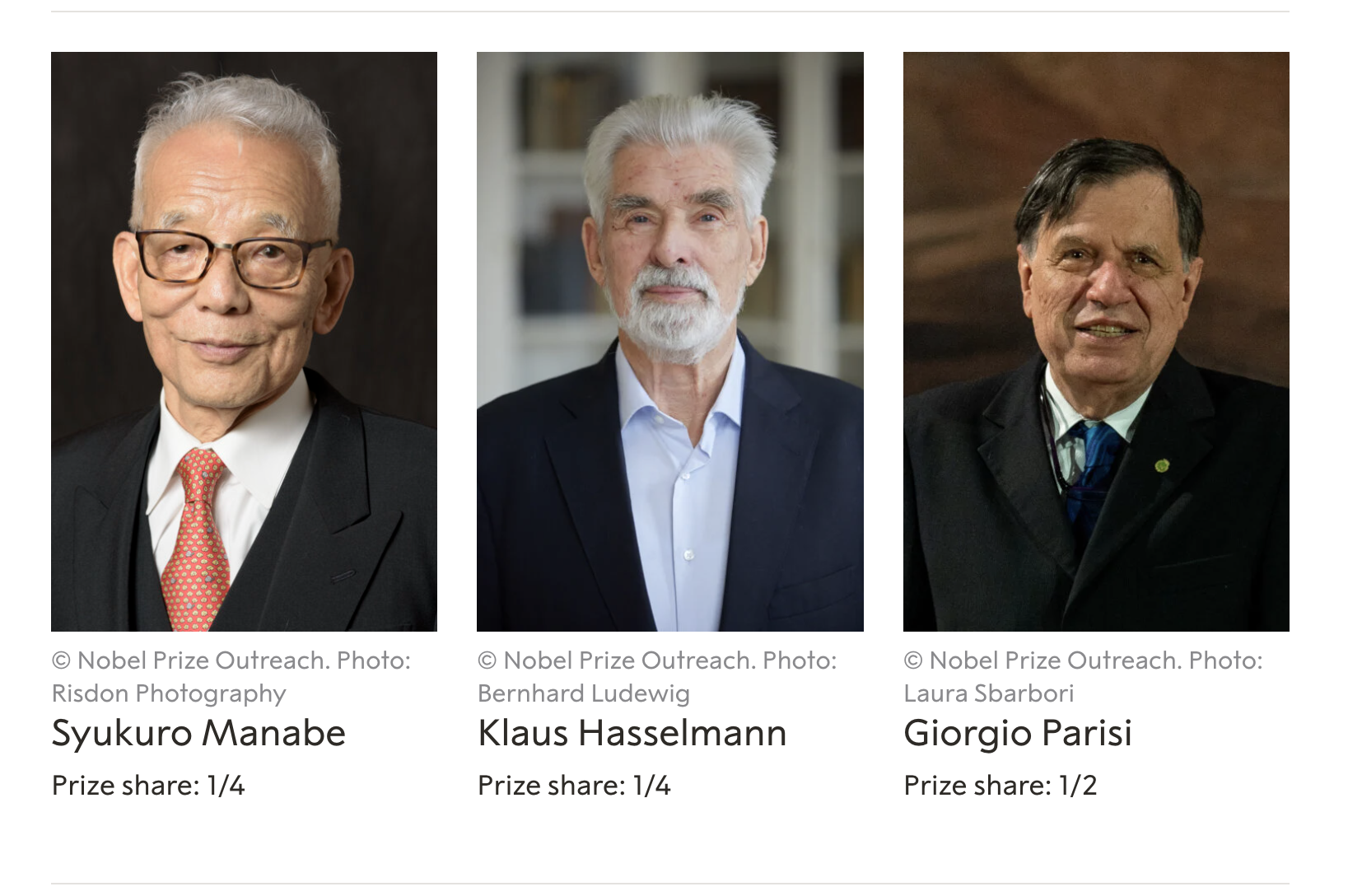
Manabe Shuro, Klaus Hasselmann, George Parisi shared the 2021 Nobel Prize in Physics.
Among them, Syukuro Manabe, a Japanese-American scientist, and Klaus Hasselmann, a German scientist, for their contributions to "building a physical model of the Earth's climate, quantifying its variability, and reliably predicting global warming" Related research was awarded to Italian scientist Giorgio Parisi for "discovering the interaction of disorder and waves in physical systems ranging from atomic to planetary scales".
Our world is full of complex systems characterized by randomness and disorder, and one of those complex systems that is crucial to humanity is the Earth's climate system.
Zhou Tianjun, a researcher at the Institute of Atmospheric Physics, Chinese Academy of Sciences, and others wrote in "Science China: Earth Science" that the efforts and accumulation of the climatology community represented by Manabe Shuro and Hasselman over a hundred years have contributed to the global warming since industrialization. The causal question provides a clear answer. The Nobel Prize official wrote in a press release, "We can't say we don't know, because the climate patterns are clear. Is the earth warming? Yes. Is it because of the increase in the amount of greenhouse gases in the atmosphere? Yes. Factors to explain? No. Are human emissions responsible for the increase in temperature? Yes.”
Parisi was born in Rome, Italy in August 1948 and works at the University of Rome. Around 1980, Parisien discovered the hidden laws of complex systems in disordered complex materials.
Wang Weihua, academician of the Chinese Academy of Sciences and director of the Songshan Lake Materials Laboratory, pointed out that Parisi's main contribution was the first to give "the simplest mathematical model in a non-parallel system" - a strict solution in the spin glass model. The theories he developed from his spin glass studies were soon extended to other disordered systems, such as structural glasses, blocked systems, and stellar motions. His discovery of the nature of spin glasses was so profound that the theory influenced not only the world of physics, but mathematics, biology, neuroscience and even machine learning.
Wang Weihua described in the article that Parisi has a flock of starlings around Parisi's office at the University of Rome, and thousands of these birds fly together in the evening. Parisi and the team developed a 3D imaging system that accumulated a large amount of flock flight data, thereby developing an interaction model that quantitatively explained the mechanism by which collective flight occurs in a flock. This model has profound implications for later studies of collective motion in various biological systems.
2020 Nobel Prize in Physics: Discovery of black holes
The 2020 Nobel Prize in Physics is awarded to three scientists. Among them, British scientist Roger Penrose won half of the prize for proving that black holes are a direct result of Einstein's general theory of relativity; German scientist Reinhard Reinhard Genzel and American scientist Andrea Ghez were awarded for the discovery of a supermassive object in the center of the Milky Way.
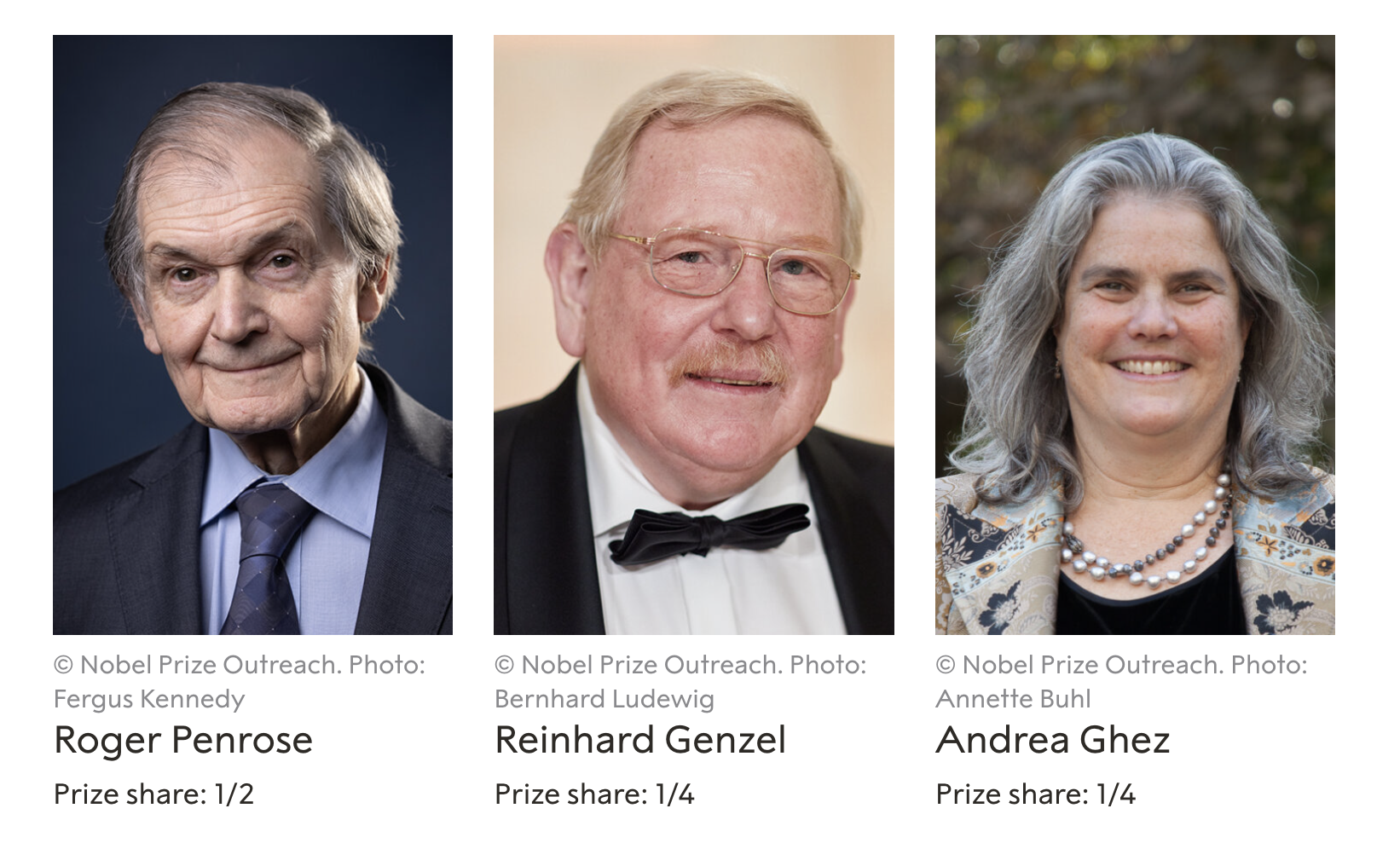
Roger Penrose, Reinhard Genzel, Andrea Getz share the 2020 Nobel Prize in Physics.
According to Jiefang Daily, black holes are the most mysterious celestial bodies in the universe. Bian Yulin, a famous astronomical science writer, introduced that black holes are an important speculation made by scientists based on the general theory of relativity. They were named by American physicist John Wheeler in 1969. It's called a "black hole" because it cannot be observed with light or other forms of electromagnetic waves, and any light that is emitted into the black hole is absorbed rather than reflected back.
Professor Cheng Ya, Dean of the School of Physics and Electronic Science of East China Normal University and a Fellow of the British Physical Society, said that the scientific community originally predicted that the 2020 Nobel Prize would not be awarded to astronomers, because the scientist who observed gravitational waves in 2017 won the Nobel Prize in Physics The 2019 Nobel Prize in Physics also goes to the field of astronomy.
But the first black hole photo may "assist" the Nobel Prize in Physics to go to the astronomy field again.
Professor Cheng Ya said that in 2019, scientists from various countries used super radio telescopes equivalent to the diameter of the earth to synthesize visible pictures of distant black holes in the form of "thousands of compound eyes of insects", allowing humans to "see" black holes for the first time. This also made the 89-year-old Penrose wait until the day when his theoretical research results were verified. Penrose is more of a mathematician. In the 1960s, on the basis of macroscopic theory, Penrose logically and accurately solved a physical world associated with black holes.
Nobel Prize in Physics 2019: Discovery of exoplanets
According to Xinhua News Agency, the 2019 Nobel Prize in Physics was awarded to three scientists: James Peebles from the United States for cosmology-related research, Michel Mayor and Didier Queloz from Switzerland Awarded for the first discovery of an extrasolar planet.
Their research points to an eternal question: Is there life beyond Earth?
Peebles' insights into cosmology have enriched research across the field, the Royal Swedish Academy of Sciences said in a press release. His theoretical framework developed since the mid-1960s and has become the foundation of contemporary cosmology.
Using the theoretical tools and computational methods he created, Peebles successfully "decoded" the "trails" left at the beginning of the universe. According to his theory, it can be deduced that 95% of the universe is composed of mysterious dark matter and dark energy, while the ordinary matter we usually observe only accounts for 5%.
It has been predicted before that there must be many stars in the sky full of stars that also have planets orbiting them. It wasn't until 1995 that Mayor and Queloz announced the first discovery of a planet outside our solar system, based on the theory that stars would wobble in tiny wiggles due to changes in the planet's gravity. It orbits a sun-like star in the constellation Pegasus of the Milky Way. Some people think that this discovery is comparable to Columbus's discovery of a new continent, which ignited the "spark fire" of exoplanet exploration, and also triggered an astronomical revolution. Since then, scientists have discovered more than 4,000 planets in the Milky Way.
2018 Nobel Prize in Physics: The Power of Light
The 2018 Nobel Prize in Physics was awarded to three researchers for their important contributions to designing tools made of light.
Arthur Ashkin from Bell Labs in the United States received this honor for his invention of optical tweezers.
Optical tweezers are a technique that uses a focused laser beam to grip and manipulate microscopic objects, including biological samples, just as people do with tweezers. Using optical tweezers, one can manipulate and move atoms, viruses and other living cells. Ashkin's invention gives researchers the opportunity to deeply analyze the molecular motors that play a key role in cells and explore how they work without damaging the cell membrane.
Gérard Mourou from the Ecole Polytechnique, France, and Donna Strickland, from the University of Waterloo, Canada, were awarded for the invention of Chirped Pulse Amplification (CPA). CPA is a technology that can greatly increase the power of laser pulses and is widely used in physics research, as well as in cancer treatment and particle acceleration. The powerful laser beam can precisely cut and drill different materials.
2017 Nobel Prize in Physics: "Seeing" Gravitational Waves
Albert Einstein predicted the existence of gravitational waves hundreds of years ago.
The gravitational wave signal generated by the collision of the two black holes took 1.3 billion light-years to reach the Earth. On September 14, 2015, it was captured by the LIGO detector in the United States. This is the first time humans have observed gravitational waves in the universe.
LIGO, the full name of "the Laser Interferometer Gravitational-Wave Observatory", is a collaborative project that brings together more than 1,000 researchers from more than 20 countries.
The gravitational waves detected three times in September 2015, December 2015 and January 2017 were all completed by LIGO alone. The detection results not only verify the general theory of relativity, but also provide clues for understanding the cause of the binary black hole system.
On August 14, 2017, two interferometers of the Laser Interferometer Gravitational-Wave Observatory (LIGO) and an interferometer of the European "Virgo" gravitational-wave detector, from three locations almost simultaneously (with a difference of only milliseconds) to capture the latest gravitational wave event.
The 2017 Nobel Prize in Physics was awarded to American scientists Rainer Weiss, Barry Barish and Kip Thorne for their contributions to the discovery of gravitational waves.
According to Xinhua News Agency, among them, Rainer Weiss is called the "inventor" of LIGO, Kip Thorne is called the spokesperson, and Barry Barish is the chief executive of LIGO.
According to Einstein's theory of relativity, spacetime can be curved, and when objects with mass move in it, gravitational waves are generated. It's like throwing a stone into water to create water waves, so gravitational waves are often called "ripples in space and time." But such gravitational waves produced by ordinary objects are extremely weak. In fact, the gravitational waves from the merger of two black holes observed by the LIGO project caused only a much smaller change in the instrument than the nucleus of an atom.
Cao Zexian, a researcher at the Institute of Physics, Chinese Academy of Sciences, once said that gravitational waves were the concept first proposed by French scientist and scientific generalist Poincaré in 1905. By analogy with accelerating charges that emit electromagnetic waves, it is reasonable to assume that accelerating masses should also generate gravitational waves. In 1918, Einstein delved into the problem of gravitational waves in an article called "On Gravitational Waves (Über Gravitationswellen)", giving the equation for gravitational waves.
2016 Nobel Prize in Physics: Discovery of new forms of matter
According to the China Science News, the 2016 Nobel Prize in Physics was awarded to scientists David Solis, Duncan Haldane, and Michael Kosterlitz for "theoretical discovery of topological phase transitions and topological phase matter" . Topology describes the properties that remain unchanged when an object is stretched, twisted, or deformed without being torn. The goal of topology is to describe shape and structure by some basic features, such as the number of potholes. So, topologically speaking, a mug and a bagel are the same because they both have only one opening, while a shortbread is different because it has two openings.
Wang Yupeng, director of the Institute of Physics of the Chinese Academy of Sciences, said in an interview with a reporter from China Science News, "The main contribution of the three people is to apply the concept of topology to physics." "They discovered a new form of matter-topological matter state. Ordinary people can see the three common states of matter: gas, liquid, and solid, and there are many classifications of material states at a deeper level." "For example, electrons, which flow when conducting electricity, can be considered as liquids physically. of."
According to Xinhua News Agency, topology was originally an important branch of modern mathematics, studying the invariant properties of objects under continuous deformation, but it gradually penetrated into the entire field of quantum physics and became an important part of studying and analyzing the continuity and connectivity of the material world. mathematical method.
As early as the early 1970s, David Solis and Michael Kosterlitz discovered that there was an error in the theory of thin-layer superconductivity at that time, and they borrowed the concept of topology to successfully explain the thin layer of matter under low temperature conditions. The superconductivity phenomenon and its occurrence mechanism and phase transition theory. Phase transition refers to the process of a substance changing from one phase to another, and substances are divided into three types: solid phase, liquid phase, and gas phase.
In 1988, Duncan Haldane used the concept of topology to explain the phenomenon of "topological quantum fluid" existing in thin-layer semiconductors in the absence of a magnetic field. His theory has made a series of important contributions to the development of condensed matter physics.
Attached is the list of Nobel Prize winners in physics in the past ten years and their contributions:
2021 Nobel Prize in Physics
"For seminal contributions to our understanding of complex systems"
Syukuro Manabe and German scientist Klaus Hasselmann "For Physical Modelling of Earth's Climate, Quantifying Variability and Reliably Predicting Global Warming"
Giorgio Parisi "discovers the interaction of disorder and fluctuations in physical systems from atomic to planetary scales"
2020 Nobel Prize in Physics
Roger Penrose "Discovery of black hole formation is a strong prediction for general relativity"
Reinhard Genzel and American scientist Andrea Ghez "discover a supermassive compact object at the center of the Milky Way"
2019 Nobel Prize in Physics
"For contributions to our understanding of cosmic evolution and Earth's place in the universe"
James Peebles "Theoretical Discoveries in Physical Cosmology"
Michel Mayor and Didier Queloz "discovered exoplanets orbiting sun-type stars"
2018 Nobel Prize in Physics
"Breakthrough Inventions in Laser Physics"
Arthur Ashkin "For Optical Tweezers and Their Applications in Biological Systems"
Gérard Mourou and Donna Strickland "Methods for generating high-intensity, ultrashort light pulses"
2017 Nobel Prize in Physics
Rainer Weiss, Barry C. Barish, and Kip S. Thorne "Conclusive contributions to LIGO detectors and gravitational wave observations"
2016 Nobel Prize in Physics
David J. Thouless, F. Duncan M. Haldane, and J. Michael Kosterlitz "Theoretical Discovery of Topological Phase Transitions and Topological Phase Matter"
2015 Nobel Prize in Physics
Takaaki Kajita and Arthur B. McDonald "Discover Neutrino Oscillation, Indicating Neutrino Mass"
2014 Nobel Prize in Physics
Isamu Akasaki, Hiroshi Amano, and Shuji Nakamura "invented efficient blue light-emitting diodes that enable bright and energy-efficient white light sources"
2013 Nobel Prize in Physics
François Englert and Peter W. Higgs, "A theoretical discovery that helps us understand the mechanisms of the origin of mass in subatomic particles, recently published by CERN's The ATLAS and CMS experiments at the Large Hadron Collider have confirmed previously predicted elementary particles"
2012 Nobel Prize in Physics
Serge Haroche and David J. Wineland "Breakthrough Experimental Methods for Measuring and Manipulating Single Quantum Systems"
2011 Nobel Prize in Physics
Saul Perlmutter, Brian P. Schmidt, and Adam G. Riess "Discover the accelerating expansion of the universe by observing distant supernovae"
